|
|
Jean Batten: The Garbo of the Skies
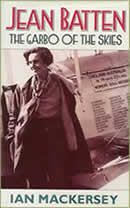
Click here to buy
Ian Mackersey
Macdonald, London, 1991
(ISBN: 0 356 19573 2)
Warner Books paperback, 1992 (reprinted 1999)
ISBN: 0 7088 3019 0
Jean Batten was one of the great aviation megastars of the 1930s. Her
spectacular oceanic flights from England to Australia, New Zealand and
South America, ranked with those of Amy Johnson and Amelia Earhart. Yet
despite her huge success as a record-breaking woman pilot and her brilliance
as a navigator, she remained the least known of the famous aviators of
that golden age of perilous journeys in flimsy open-cockpit aeroplanes.
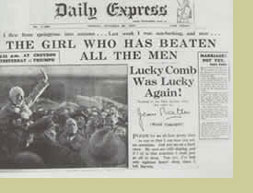 Although
exceedingly famous in her day, regularly making front-page headlines,
being mobbed by large crowds, feted by the crowned heads of Europe,
the beautiful dentist’s daughter from New Zealand built an
impenetrable wall of secrecy around her private life. It was a life
dominated, few people knew, by the shadowy, some said Svengali,
figure of her mother Ellen, a thwarted actress who lived out her
own adventure fantasies through her daughter, pushing her to make
one dangerous flight after another. But so secret remained their
close and interdependent life together that, in the late 1980s,
when Ian Mackersey set out to research Jean’s career, the fullest
ascertainable summary of it was a mere 25-line entry in Who’s
Who. What’s more she had carefully ensured that this made no
reference to her existence after 1937. It was as if, at the age
of twenty nine, her life had stopped. Although
exceedingly famous in her day, regularly making front-page headlines,
being mobbed by large crowds, feted by the crowned heads of Europe,
the beautiful dentist’s daughter from New Zealand built an
impenetrable wall of secrecy around her private life. It was a life
dominated, few people knew, by the shadowy, some said Svengali,
figure of her mother Ellen, a thwarted actress who lived out her
own adventure fantasies through her daughter, pushing her to make
one dangerous flight after another. But so secret remained their
close and interdependent life together that, in the late 1980s,
when Ian Mackersey set out to research Jean’s career, the fullest
ascertainable summary of it was a mere 25-line entry in Who’s
Who. What’s more she had carefully ensured that this made no
reference to her existence after 1937. It was as if, at the age
of twenty nine, her life had stopped.
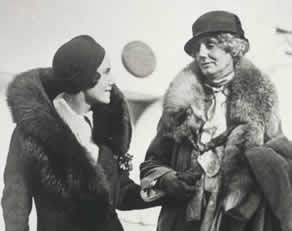 |
| Jean Batten and her mother, Ellen, who dominated and controlled her |
More obsessed with the need for fame than most of her contemporary
women aviators Jean also took herself more seriously. Driven by
an extraordinarily ambitious and reckless force she maintained an
image of awesome perfection. Her crowded years of glory, however,
were brief. They endured only from 1933 to 1937. As suddenly as
it had arrived, her name dropped out of the headlines. She simply
disappeared, going off to resume a nomadic life with her mother.
The two moved from country to country, footloose, giving their address
to no-one, living out of cheap boarding houses and briefly rented
apartments in obscure places.
For more than thirty years Jean Batten’s celebrity and exploits
were forgotten – until 1969 when, to the astonishment of the
aviation world, at the age of sixty, she staged a spectacular comeback.
She had a face-lift, died her grey hair jet black and reappeared
in the aviation limelight wearing a mini skirt and looking not a
day older than forty.
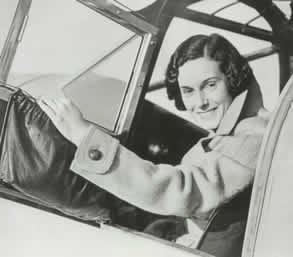 |
| Jean in the cockpit of the Percival Gull in which she became the first woman to fly the South Atlantic and from England to New Zealand. |
For more than ten years the re-emerged 1930s flying heroine was
a highly visible figure, travelling the world, involving herself
in aeronautical events, giving interviews to newspapers, radio and
television, as she set about rebuilding her long-forgotten image
of fame.
But, in 1982, something bewildering happened. Now in her early seventies,
lonely and no longer in public demand, she flew from England to
the Mediterranean island of Majorca, intending to buy an apartment
and spend her remaining years there. Within five weeks of arriving
in the island’s capital, Palma, she vanished.
For five years Jean Batten’s whereabouts remained a baffling
mystery, defying the search efforts of family and the diplomatic
enquiries of governments. For five years nobody heard from her.
Her London bank account remained untouched. Wild theories circulated.
Had she deliberately gone to earth – something she had done
before – intending to re-emerge amid a fresh burst of publicity?
Had she become ill and incapacitated and was being cared for somewhere
by people unaware of her identity? Gone into retreat in a Majorcan
convent? Was she living under an alias somewhere? Drowned during
her ritual daily swim – or had simply walked into the ocean
to end a lonely life? There were other theories: that she had secretly quietly
returned to New Zealand, to the land of her birth – or to Australia
where she had been secretly engaged to an airline pilot who had
been killed in a crash in 1937.
In late 1986 when Jean had been missing for over four years Ian
Mackersey set out from Auckland to try and establish her fate for
a televsion documentary and book. He and his wife, Caroline, decided
to mount their own international detective operation and to try
and unravel the details of her extraordinarily secret life. Initially
with their own financial resources they travelled the world for
nearly 12 months, tracking down everyone they could find who had
ever known her.
They searched in her homeland, New Zealand, in Australia where her
intended husband lay buried in mountain jungle on the Queensland/New
South Wales border. They looked in England where she had once been
engaged to a stockbroker and where other men in love with her had
helped to fund her flights. In England, where she had once mixed
in grand circles as her great flights made dramatic headlines, and
where still lived, in the late 1980s in obscurity in Essex, her
brother John, a former Hollywood silent movie actor with whom she
had fallen out; they had not spoken for fifty years.
The search spread to Jamaica where Jean and Ellen, for several years
immediately after the Second World War, lived largely anonymously
in a house shielded by the high wall they built beside the Caribbean
Sea. To southern Spain where, in a fishing village near Malaga the
Battens had gone in the late 1950s to live for six years. To Tenerife
where, in 1966, Ellen had died and Jean, lonely and in protracted
grief and deep depression, had retreated for nearly four years to
a tiny apartment in Puerto de la Cruz from which she would occasionally emerge, always with her face carefully concealed under a large wide-brimmed hat.
To Majorca where Jean, in October 1982, had flown into final oblivion.
It was in Majorca, in the city of Palma that the Mackerseys, in
September 1987, finally solved the, by then, five year long mystery
of the missing aviator.
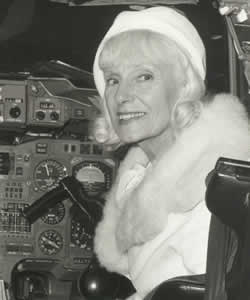 |
| Still glamorous in her sixties, Jean at the height of her return to public life in the 1970s. |
In a small room in a seedy hotel, just five weeks after her arrival
in Majorca, Jean Batten had died a tragic, lonely death. Bitten
by a dog, she had refused medical attention. The dog was not rabid,
but infection had spread to her lungs as she spurned the antibiotics
that would have saved her. Among the Spanish hotel staff, ignorant
of her former great celebrity, she had died a needless death, overwhelmed
by a pulmonary abscess.
Jean Batten’s New Zealand passport was found among her sparse
possessions but, as a result of an administrative bungle by the
local Spanish authorities, neither the New Zealand government or
any of her relatives were ever informed. In January 1983 the famous
woman pilot had been buried anonymously in an unmarked pauper’s
grave in Palma cemetery.
Ian Mackersey’s biography Jean Batten: The Garbo of the
Skies, and TV documentary of the same name, drew on Jean’s
secret unpublished memoirs found in a battered suitcase after her
death to help unfold the full story of her extraordinarily covert
life. The book and the television programme revealed for the first
time the truth of her unique relationship with the mother who ruled
her life, the men who made her flights possible and the world-wide
search to establish her ultimately tragic fate.
An international film production company has acquired the big screen movie rights to the biography.
The TV documentary can be viewed on-line at www.nzonscreen.com
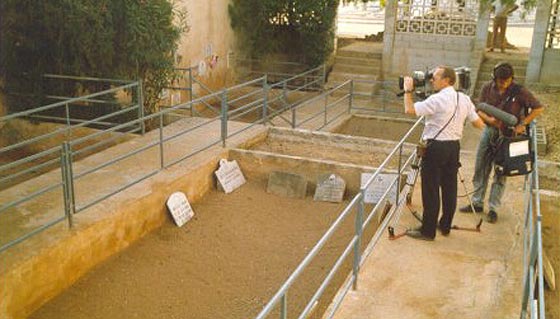 |
| The communal grave in Palma cemetery, Majorca, in which Jean Batten was buried anonymously in January 1983. |
What the critics said of Jean Batten: The Garbo of the Skies
Daily Mail (London): ‘Glued to this book for two whole
days I find it impossible to over-praise a story which reads like
a superior detective novel while bringing a totally new depth
of understanding to this extraordinary woman.’
Sunday Telegraph (London): ‘What makes Ian Mackersey’s
study of her rewarding is not the recital of her feats, but the
analysis of her character.’
The Spectator: ‘As a study of the illusion of celebrity
it is exemplary.’
The Guardian: ‘Ian Mackersey’s tireless digging
has done Jean, her family and aviation history a great service.’
New Zealand Herald: ‘But the greatest tribute of all
is this engrossing biography that Mackersey has so honestly, so
thoroughly, sometimes so cruelly yet so lovingly, amassed. Jean
Batten will not die while this book lives.’
TV Documentary Film
Jean Batten: The Garbo of the Skies
1988 Ian Mackersey Productions 52-minute television
programme for Energy Source Television in Association with TVNZ
Written and produced by: Ian Mackersey
Assistant producer: Caroline Mackersey
Executive producer: Peter Sainsbury
A finalist for the New Zealand Film and Television Awards, Jean
Batten: The Garbo of the Skies was screened in Britain by
the BBC, in America by the Discovery Channel, and in Spain, Denmark,
Sweden and China.
The film revealed publicly for the first time the full story of
the closely-guarded private life of the glamorous 1930s aviation
megastar and her powerful, domineering mother. It traced her career
from unhappy childhood in New Zealand to fame and international
adulation as a courageous pilot and superb navigator of small
frail aeroplanes on dangerous record bids around the world. The
documentary followed Jean Batten’s descent into lonely obscurity
in wartime Britain, in Jamaica, Spain and Tenerife; her astonishing
return to the aviation stage as a faded celebrity in her sixties,
and her final loneliness that culminated in the five-year mystery
of her disappearance and death in the room of a small hotel in
Majorca.
Jean’s spectacular career and her covert private life are
traced by the film with footage of her flights, narration from
her unpublished memoirs, reconstructions of some of her most terrifying
moments in the air and interviews with many people who knew her.
Jean Batten’s Principal Flights 1933 (9 – 16 April) England-Karachi. De Havilland Gipsy
M Moth with Gipsy II engine (G-AALG). After series of forced landings
crashed following engine failure on approach to Karachi, thus
ending first attempt to fly to Australia.
1934 (21 April) England-Rome. De Havilland Gipsy M Moth with
Gipsy I engine (G-AARB). This second Australia attempt ended in
disaster when she ran out of fuel and crashed in rain and dark
in the middle of the San Paolo wireless station in Rome. After
major repairs to the aircraft she flew it back to Brooklands on
5-6 May for a third attempt.
1934 (8 – 23 May) England-Australia. Gipsy Moth (G-AARB).
Women’s solo record of 14 days 22 hours 30 minutes from Lympne
to Darwin, beating Amy Johnson’s 1930 time by over 4 days
for the 10,500-mile flight. Reached Sydney 30 May.
Route: Lympne – Marseille – Rome –
Brindisi – Athens – Cyprus – Damascus – Rutbah
Wells – Bagdad – Basra – Bushire – Jask –
Karachi – Jodhpur – Allahabad – Calcutta –
Akyab – Rangoon – Victoria Point – Alor Star –
Singapore – Batavia – Lombok – Kupang – Darwin
– Katherine – Newcastle Waters – Brunette Downs
– Camooweal – Cloncurry – Blackall – Charleville
– Bourke – Narromine – Sydney.
 |
| Jean Batten and her fiance, English stockbroker Edward Walter who lent her the wings from his own aeroplane. |
1935
(11 – 13 November) England-Brazil. Percival Gull
6 with Gipsy Six engine (G-ADPR). World absolute record (for
pilots of either sex in any type of aircraft) of 2 days 13
hours 15 minutes for the 5,000-mile flight from Lympne to
Natal and of 13 hours 15 minutes for the 1,900-mile South
Atlantic crossing from Thies in Senegal to Natal in Brazil.
First woman to fly herself from England to South America.
Route: Lympne – Casablanca – Villa
Cisneros – Thies – Natal –Araruama (forced
landing on beach compelled by fuel leak) – Rio de Janeiro
– Pando – Buenos Aires – Montevideo –
Buenos Aires.
1936 (5 – 16 October) England-New Zealand. Percival Gull 6
(G-ADPR). World absolute record: 14,224 miles in 11 days 45 minutes total
elapsed time which included 2 1/2 days stopover in Sydney. First direct
flight from England to New Zealand and world absolute record for flight
from Australia to New Zealand (Sydney-Auckland in 10 1/2 hours). Also
broke England-Australia solo record (for either sex) with Lympne-Darwin
time of 5 days 21 hours.
Route: Lympne – Marseilles – Brindisi –
Cyprus – H3 landing ground (Syrian Desert) – Basra – Karachi
– Allahabad – Akyab – Penang – Singapore – Rambang
– Kupang – Darwin – Brunette Downs – Longreach –
Charleville – Sydney – Auckland.
1937 (19 – 24 October) Australia-England. Percival Gull 6 (G-ADPR).
Solo record (for either sex) of 5 days 18 hours 15 minutes becoming first
person to hold both England-Australia out and back solo records simultaneously.
Route: Sydney – Charleville – Winton –
Camooweal – Newcastle Waters – Daly Waters – Darwin –
Rambang – Batavia – Alor Star – Rangoon – Allahabad
– Karachi – Basra – Damascus – Athens – Naples
– Marseilles – Lympne – Croydon. |
 |
|
|